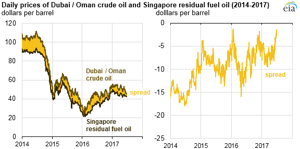EIA: Low inventories, supply developments affecting Asian residual fuel oil prices
The difference between high-sulfur residual fuel oil prices in Singapore and crude oil prices in Dubai/Oman has been narrowing since the spring. Low inventories of residual fuel oil in Singapore and lower residual fuel oil production from Russia are likely contributing to the narrowing price spread.
Residual fuel oil, the petroleum product remaining after higher-value liquids such as gasoline feedstocks and distillate are distilled from crude oil, typically sells at a lower price than crude oil. Residual fuel oil is used in many sectors, including marine transportation, power generation, commercial furnaces and boilers, and various industrial processes.
For many Asian countries, petroleum product prices tend to follow Dubai/Oman crude oil, which is the benchmark Middle Eastern crude oil exported to Asia. Moreover, because Singapore is the largest global hub for marine ships to refuel, the residual fuel oil spot price at Singapore is considered representative of the region. Dubai/Oman crude oil is classified as a medium and sour crude oil because of its relatively low API gravity (density) and high sulfur content compared with light, sweet crude oils such as Brent.
Relatively high demand and relatively low inventories are both contributing to the increase in the price of Singapore residual fuel oil relative to the price of Dubai/Oman crude oil. In Singapore, residual fuel oil inventories were 22.2 MMbbl for the week ending June 28, slightly below the five-year average for this time of year but recovering from when they were more than 6 MMbbl below the five-year average at the beginning of June. Residual fuel oil sales were up 4% year-to-date through May, according to the Maritime and Port Authority of Singapore. The recent diplomatic dispute between Qatar and Saudi Arabia, Bahrain, Egypt, and the United Arab Emirates, which included a ban of Qatari-flagged vessels entering the United Arab Emirates port of Fujairah, may have led some vessels to refuel in Singapore instead.
Regional crude oil production decisions are also affecting relative prices. The voluntary crude oil production reductions from several countries within and outside the Organization of the Petroleum Exporting Countries (OPEC), who tend to produce medium- and sour-grade crude oils, reduce the availability of these grades to refiners. Because of their relatively low API gravity (density), medium and sour crude oils yield more residual fuel oil from distillation than light, sweet crude oils. As regional refineries run more light, sweet crude oil, less residual fuel oil is being produced.
Russia, traditionally a large producer and exporter of residual fuel oil, has also reduced its production and exports over the past year. Several major Russian refiners completed investments in secondary refinery units, allowing them to further process residual fuel oil into higher-value liquid fuels. Furthermore, changes in Russia’s export taxes have affected their trade. Before 2017, Russian exports of residual fuel oil were taxed at a lower rate than Russian exports of crude oil. In January, however, the tax rate for residual fuel oil was raised to equal that for crude oil.







Comments